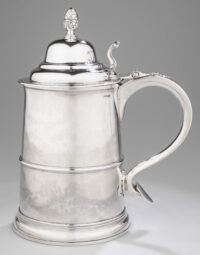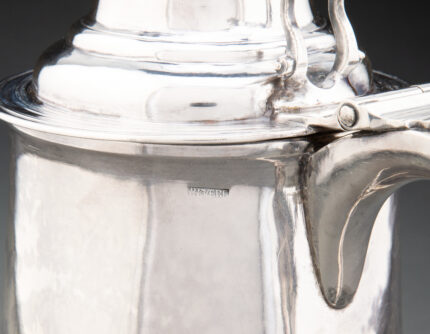 The Colonial Williamsburg Foundation has acquired a rare silver tankard made by Paul Revere, colonial America’s premier silversmith and the Revolution’s premier midnight righter. There are only about three dozen known Revere tankards. The tapering sides, midband, domed line and pinecone finial dates this one to around 1795, but researchers are still looking through Revere’s many extant record books to trace it directly back to its origins.
The Colonial Williamsburg Foundation has acquired a rare silver tankard made by Paul Revere, colonial America’s premier silversmith and the Revolution’s premier midnight righter. There are only about three dozen known Revere tankards. The tapering sides, midband, domed line and pinecone finial dates this one to around 1795, but researchers are still looking through Revere’s many extant record books to trace it directly back to its origins.
The silver tankard was sold at auction in May of this year for $112,500, including buyer’s premium. The Friends of Colonial Williamsburg Collections Fund provided the wherewithal to add this exceptional piece, one of the largest forms produced by Revere’s silver shop, to the Colonial Williamsburg museum holdings.
Colonial Williamsburg’s Revere tankard stands nearly 10 inches tall and holds 48 ounces of liquid (usually wine, ale or cider), making it weighty to lift when full. Its apparent size is enhanced by a stepped domed lid and an elongated finial. The tankard has a lighter appearance thanks to its scrolled openwork thumbpiece. It lacks engraving, which leaves the identity of the original owner a mystery. Details such as the decorative features and the substantial weight (nearly 34 troy ounces) may one day provide ownership clues through careful study of Revere’s shop records.
“Paul Revere is the best-known and most celebrated American silversmith,” said Janine E. Skerry, Colonial Williamsburg’s senior curator of metals. “A large, eye-catching object such as this tankard is a great way to connect with the public and draw both children and adults into the story of this amazing material and its role in our early history.”
The tankard will now join the other recently-acquired example of Revere silver — a small porriger made around 1765 — in the new exhibition of Colonial Williamsburg’s permanent silver collection at the DeWitt Wallace Decorative Arts Museum.
“Colonial Williamsburg has long sought a significant example of Revere’s work,” said Ronald L. Hurst, the Foundation’s Carlisle H. Humelsine chief curator and vice president for museums, preservation and historic resources. “With its impressive size, fine detail, and excellent condition, this tankard fills a significant void in our American silver holdings.”

That thing clearly is a Beer(!) mug.
So far, I was unaware of “fluid” ounzes, let alone any US versions of that, but folks from Europe might want to know that 48 usfluidounce = 1.4195294 liter = 3 pint = 2.8390588 seidla (cf. “situla”).
The design is just perfect, but of course –only– the “seidla” variants (i.e. 0.5 liter) are acceptable for any practical use :yes:
——————-
“Beer steins were made primarily with pewter in many areas across Europe (primarily in England), but many steins were known to be made of glass, porcelain, and silver as well. Steins have also been known to have been made out of wood, earthenware, and crystal. Ordinary German beer mugs have been made out of glass for hygienic reasons since the introduction of glass mugs to the 1892 Oktoberfest. Modern beer mugs, except again decorative or luxury versions, do not have a lid. Beer mugs (0.5 and 1 litre) are typical for beer gardens and especially the Oktoberfest, where they are popular for their robustness.”
——————-
Back then, his ‘seidla’ was only slightly more than 0.5 liter, but (De) Kalb), a peasant from my hometown, joined the French Army, and was sent over to the US –to help the Colonists to get rid of the pint– first in in 1768, and later in 1777 with Lafayette.
Unfortunately, he was killed in 1780 in the Battle of Camden. Hence the “fluid” ounzes, I presume..
:hattip:
Good point, sir. All substances are measured by volume or weight.
Cheers to Mr. Revere, ein Prosit, to his health, salud and all that – wherever he may be. I’ll drink a pint to that.
…Cheers to you, Albert (and the others).
Just wanted to make it a little clearer that “pint” (foam of course not included!) –and when not at home– sounds perfectly legit to me 😉
———
PS: That ‘pinecone’ seems to be a “hops” flower.
Paul Revere, apparently a descendant of French Huguenots, seems likewise rehabilitated.
What I calculated –by naively just typing “pint” in units– had in fact been “US liquid pints” (48/16).
48 usfluidounce = 3 uspint (brfluidounce 1|20 brpint)
48 usfluidounce = 2.4980226 imperialpint (while 48/20 = 2.4)
48 usfluidounce = 2.4980226 brpint (1 brpint = 568.26125 ml, SI!)
Hence, 1 brpint = 1.1365225 seidla (or 1 Seidla plus foam, while 1 uspint = 0.94635295 seidla).
🍻 🍺 :boogie: